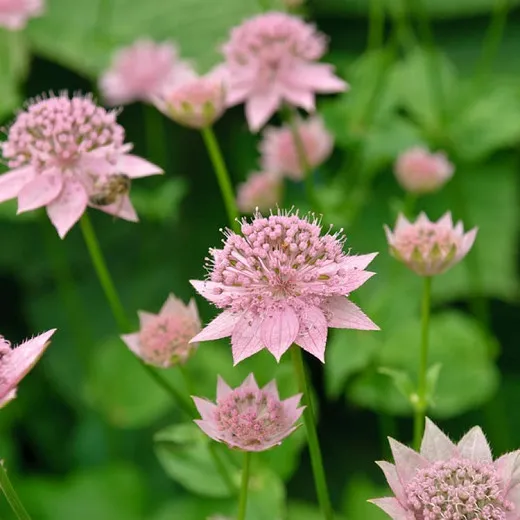Astrantia maxima, commonly known as Masterwort, is a charming perennial plant known for its large, dome-shaped flowerheads consisting of tiny soft pink flowers surrounded by elegant papery bracts.

This distinctive and elegant plant has several notable features:
Description:
- The flowers of Astrantia maxima are held in a dome-shaped cluster, resembling pins on a cushion. The flowerheads are 2-3 inches (3-6 cm) wide.
- The flowerheads are supported by branching stems that rise well above the rosette of lush green, deeply divided tripartite foliage.
- The papery bracts surrounding the flowers create an eye-catching ruff that adds to the plant’s visual appeal.
Blooming Season:
- Astrantia maxima blooms for several weeks, typically from late spring to early summer. In conditions favorable to its growth, it may also produce sporadic blooms throughout the summer.
Size:
- This Masterwort grows to a height of 20-28 inches (50-70 cm) and spreads to about 18-24 inches (45-60 cm). It forms a neat clump from the rootstock.
Cultural Requirements:
- Astrantia maxima thrives in both full sun and part shade, but it prefers cooler summer climates and doesn’t do well in very hot, humid, or dry conditions.
- The plant requires rich, well-drained soils that are consistently moist. It’s important to keep the soil adequately watered, as dry conditions can affect its growth.
Landscape Uses:
- Astrantias are versatile and valuable components of various garden designs, including herbaceous borders, cottage gardens, coastal gardens, and woodlands.
- They mix well with other plants and are particularly attractive when combined with ornamental grasses, sedums, and various perennials.
- Astrantias can be planted in drifts or at the front of mixed borders, allowing their attractive blooms to be easily appreciated.
- The plant’s cut flowers are highly valued for both fresh bouquets and dried floral arrangements.
Cultural Traits:
- Astrantias are easy to grow and are resistant to deer and pests.
- They can be propagated from seeds sown in pots in a cold frame as soon as the seeds are ripe. Division in spring is another method of propagation.
- Deadheading the spent flowers will extend the blooming period and prevent self-seeding. While they spread a little, their growth can be controlled.
- Astrantias belong to the Apiaceae family and are native to woods and meadows in Asia and Europe.
In summary, Astrantia maxima, or Masterwort, is a highly appealing perennial plant known for its distinctive dome-shaped flowerheads, elegant foliage, and suitability for a range of garden styles. Its charming appearance, adaptability to different conditions, and ability to attract pollinators and provide cut flowers make it a sought-after addition to gardens and floral arrangements.








